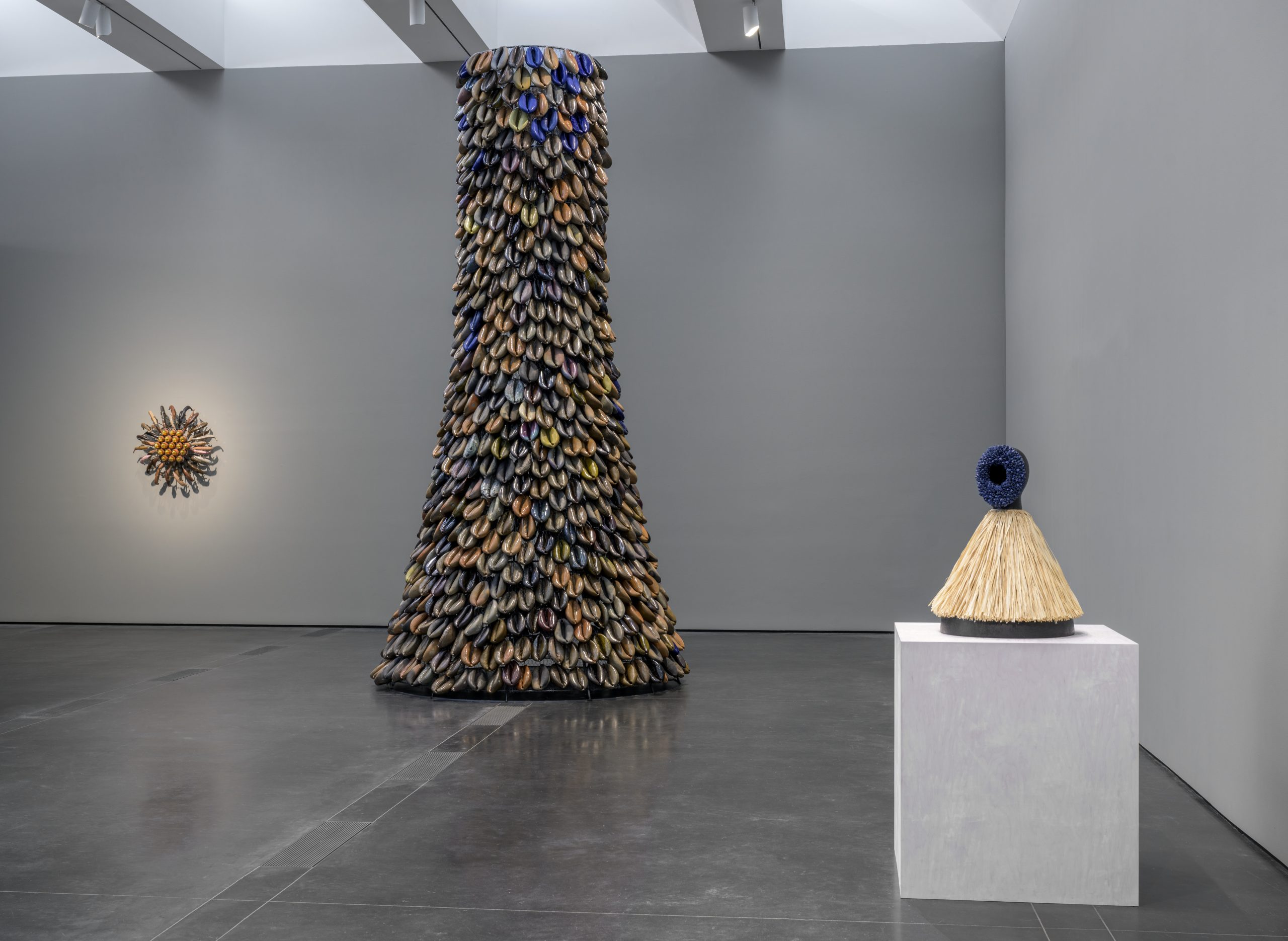Decolonization is a creative process as well as a critical one. Gabriel Vital Dubray’s mid-19th-century statue of Martinique native Joséphine Bonaparte—who was believed to have encouraged her husband, Napoleon, to reinstate slavery in the French colonies in 1802—once stood in a public park in Fort-de-France. The despised symbol of colonialism was decapitated and splattered with red paint in 1991 and finally toppled during the anti-racism protests of 2020. Simone Leigh’s Martinique, now on view in “Simone Leigh” at both LACMA and the California African American Museum, resurrects the piece as an avenging (if headless) angel cloaked in a cobalt blue glaze, cupping her naked breasts in an African gesture of welcome—a bold testament to the artist’s talent for fusing the past and present, global and local, intimate and monumental in a seamless loop. This show, organized by the Institute of Contemporary Art in Boston, is the first survey of Leigh’s work, including pieces made for the 2022 Venice Biennale, where she represented the United States, becoming the first Black woman to win the Golden Lion.
Leigh centers the bodies and lives of Black women, often calling attention to (and deliberately subverting) the stereotypical ways they have been represented in Western art and archival images. Last Garment (2022), for example, depicts a woman washing clothes in a vast, black reflecting pool, her stooped pose taken from an 1897 souvenir stereoscopic photograph of a Jamaican laundress. Other works insert Black women into the European art historical canon: Herm updates and feminizes the ancient Greek pillar with a female torso and a striding foot, mapping out a different kind of crossroads. A 2011 video collaboration with Chitra Ganesh shows a reclining nude, a pile of small white stones covering her entire head—both classical Venus and medieval martyr.

Over two decades, Leigh has forged her own visual language, which she layers and remixes at different scales and in different materials: clay, glass, bronze. Gourds take on the contours of breasts, filled with salt and tipped with gold nipples; clay coils suggest bananas, tusks and phalluses; rosettes form curls and crowns; cowrie shells—historically used as both charms and currency, including in the slave trade—become torsos, heads, mouths and vaginas. Leigh has described her work as an attempt “to collapse time,” putting a wryly contemporary spin on traditional African diasporic art and colonialist ethnographic artifacts.

Many of her studies of the female form incorporate vessels or architectural elements, highlighting Black women’s often-overlooked role in providing sustenance and shelter. Large skirts are a recurring motif; Leigh uses a 1940 image of “Mammy’s Cupboard”—a diner in Natchez, Mississippi, in the form of a black woman with a full crinoline skirt—as a touchstone, repeatedly reinterpreting this racist roadside attraction as a strong, regal, larger-than-life matriarch. Two sculptures in the show share the title Cupboard: one, a gleaming gold and bronze version, guards the entrance to CAAM, much as Satellite stood sentinel outside the American Pavilion at the Biennale. The other is made of raffia (dried palm leaves) on a crinoline-like steel armature, topped with a giant cowrie shell, its toothed aperture suggesting a spine. The raffia takes the form of the skirt, but its colossal scale also evokes the Congolese huts exhibited in the 1931 Paris Colonial Exposition, another frequent point of reference.
Most of these figures are anonymous, even faceless, if not headless. But the show includes Leigh’s first-ever portrait, 2022’s Sharifa, of writer Sharifa Rhodes-Pitts, who also served as the model for Last Garment. The massive bronze figure leans against a wall, a single, conspicuously abstracted foot protruding from her long skirt, referencing Egyptian statuary.

Besides Herm, new works include Bisi—a female form whose cocoon-like skirt accommodates Leigh’s own body—and an updated version of Kool-Aid, referencing the bright color palette of the AfricCOBRA art movement founded in 1968 in Chicago, Leigh’s hometown. The LACMA exhibition is dominated by Untitled (after June Jordan), a 16-foot-high conical tower of oversized porcelain cowrie shells named for the late Jamaican-American poet, who—in the wake of the 1964 Harlem riots—collaborated with architect Buckminster Fuller to design high-rise housing for the devastated neighborhood, which was never built. Leigh finished her version days before the opening.
Leigh’s queer, Black, feminist art deliberately defies categorization, spanning diverse media, artistic traditions, geographies and times. It is equally at home among contemporary art and more historically focused collections. However, dividing these twenty-seven sculptures and three videos between two Los Angeles venues blunts their impact. Though the material represents more than 20 years of Leigh’s practice (2001-2024), most of the LACMA pieces are recent works. Both venues suffer from hard-to-find and hard-to-read wall text; LACMA is especially guilty of treating the material as a contemporary art installation rather than half of a retrospective. (A gallery guide suggests that this is the artist’s preference as much as a curatorial choice: “She doesn’t want to have a label on every single work and doesn’t want to give too much away.”) Both exhibitions feel sparse; the whole is less than the sum of its parts, and Leigh’s distinctive iconography is diluted rather than distilled.
The venues are in different parts of a sprawling, traffic-clogged city and have different institutional priorities and policies: admission to CAAM is free, while LACMA has a complicated pricing structure with some free options but a top sticker price of $28. With parking, a visitor could easily spend $64 (plus gas) to see both parts of the exhibition, which tends to undermine any argument for splitting up the show in the name of accessibility. That money might be better spent on the substantial exhibition catalogue edited by curator Eva Respini, which more effectively captures and contextualizes the unsettling beauty of Leigh’s work.
“Simone Leigh,” a traveling exhibition organized by ICA Boston and co-presented in Los Angeles by LACMA and the California African American Museum, is on view through January 20, 2025.

